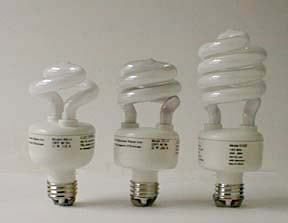| Here is a great Trivia question for any game: What year did energy saving fluorescent bulbs become available in America? You need a hint? Okay, below is a photo of the first energy saving bulb in the United States: For some, this hint may make the question harder to answer. The reason is because most of us have come to recognize the following images as energy saving bulbs: Alas, these twist shape bulbs are about the 5th generation of energy saving fluorescent bulbs in America. So if you were thinking that the answer was the year 2002, 1998, or 1995, then (cont. above) | you will have to guess again. In fact, these twist shape bulbs are no longer new. LED bulbs are already on the market and while they are still being developed into different sizes they are already second for being the NEW KID on the block. The newest generation of energy saving bulbs to become available, yet still in need of major design development, are the NEW Cold Cathode bulbs. Now since prices are very high for LED flood lights, over $45.00 a flood, these new Cold Cathode bulbs that last almost as long as LEDs may become the best buy. Below is a sneak peek, perhaps the first time look at a Brand New Cold Cathode bulb: Here are some of the "specs" on the new Cold Cathode bulb: The bulb shown above is 5 watts and gives off 25 watts of light. They work on dimmer switches perfectly. They can even blink on and off with Christmas decoration lights. They work outside and in the cold, however, the drawback is that 3, 5, & 8 watts is all they can make for now. Research continues, but (cont. above) | the best feature about these bulbs is a lamp life that will last 25,000 hours! A standard incandescent bulb only lasts 750 hours and the less expensive energy saving fluorescent bulb that you find in stores last 8,000 to 10,000 hours. So about now you are thinking that the first energy saving bulb in the U.S. came out around 1987. Getting warmer, so keep trying. Actually, the first bulb that was called a SL-18 (since its 18 watts gave off 75 watts of light and lasted 10,000 hours), became available in the year 1982. Yes, over 25 years ago. Now You may have been one of the few saving money on the electric bill and helping with environmental issues all this time by buying a bulb back then. Unfortunately, for energy saving bulbs to become readily available to the general public it has taken almost twenty years! This has been a very frustrating issue for us at EnergyHotwire. While we have been educating, talking, and showing energy saving bulbs over all these years, the bottom line was not big enough from sales of this very first energy saving bulbs. So North American Philips Lighting, who held the Patents, didn't increase production. The other large lighting companies in the U.S. were not interested because they made more money selling their regular incandescent (cont. below) |
light bulbs that they produced. In 1982, the word around the industry was that it cost only "seven pennies" from raw material to supermarket shelf to make a 75 watt bulb. A bulb that sold for $1.15, or around .85 cents when on sale. A bulb that burned-out after only 750 hours of use, thus guaranteeing repeat business. So why would a major manufacturer make an energy saving bulb that would last 10,000 hours and kiss goodbye all those profits from an inefficient incandescent light bulb? This was a product with a huge mark-up and who would care that it was so grossly inefficient?
The incandescent bulb is so inefficient that out of the 100% of electricity used to operate the bulb, 90% generates heat! Only 10% of the electricity consumed produces light! Nevertheless, the new SL-18 light bulb would have to wait five years before any sustained interest would materialize. Even during the twenty anniversary of Earth Day back in 1990 when the third generation energy saving bulbs were available, they still were not readily available to the general public in stores. These new energy saving fluorescent bulbs saved you money, but their price tag scared people away. Stores were not about to pay sales people to learn the facts on these bulbs and then explain to each and every customers how this more expensive bulb was actually less money in the long run. After all, a homeowner was not going to buy a case of these bulbs, just one, and to spend ten minutes trying to educate a shopper on the spot for the sale was not worth it.
The end results: years had to pass, patents had to expire, educated consumers had to prevail, demand had to increase, the price of oil had to go up, corners were cut to make cheaper versions of these energy saving bulbs, quality had to be sacrificed for prices to come down, and thus valuable time to save energy and money was lost.
So by now you have all read or heard how much can be saved by just changing one light bulb. We have been saying that for over 25 years. Can you imagine how much we and our country could have saved if this was all perceived back in 1982... Just water under the bridge now and the water isn't that clean.
Updated Blog Post - Article on EnergyHotwire.com to GoingTrueGreen.com Blog
Bill Lauto, at GoingTrueGreen.com
Environmental Scientist
International Sustainability and Energy Consultant
Contribute your comments!
























